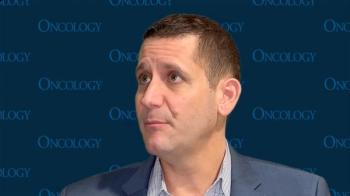
Better Survival Rates Noted With Ifosfamide for R/R Ewing Sarcoma Vs Topotecan Plus Cyclophosphamide
Ifosfamide leads to slightly better event-free and overall survival vs topotecan/cyclophosphamide in relapsed or refractory Ewing sarcoma.
Patients with relapsed/refractory Ewing sarcoma treated with ifosfamide (Ifex) vs topotecan (Hycamtin) plus cyclophosphamide saw small improvements in event-free survival (EFS) and overall survival (OS), according to findings from the phase 2/3 rEECur trial presented at the
At a median follow-up of 40 months, patients treated with ifosfamide experienced a median EFS of 5.7 months (95% CI, 3.8-6.9) compared with 3.5 months (95% CI, 3.8-6.9) for patients who received topotecan plus cyclophosphamide. The 6-month EFS rates were 47% (95% CI, 35%-58%) and 37% (95% CI, 26%-48%), respectively.
Additionally, patients who received ifosfamide achieved a median OS of 15.4 months (95% CI, 11.3-20.9) compared with 10.5 months (95% CI, 7.2-15.0) among patients treated with topotecan plus cyclophosphamide. The 1-year OS rates were 55% (95% CI, 43%-66%) and 45% (95% CI, 33%-56%), respectively.
“Given the observed data, there is a 96% probability that ifosfamide is better than topotecan plus cyclophosphamide for EFS,” Martin McCabe, PhD, said in a presentation of the data. “[However], the numbers [of patients] beyond 6 months are extremely small. There was a 94% probability that ifosfamide is better than topotecan plus cyclophosphamide for OS. Again, [there are] very small numbers [of patients] beyond about 2 years. The benefits of ifosfamide over topotecan plus cyclophosphamide were more obvious in children than in adolescents and adults.”
McCabe is a clinical senior lecturer at the University of Manchester in England.
The rEECur trial was a multi-arm, multi-stage adaptive design study with Bayesian analysis. Patients were randomly assigned to receive topotecan plus cyclophosphamide (n = 163), irinotecan plus temolozomide (Temodar; n = 127), gemcitabine and docetaxel (n = 72), or ifosfamide (n = 83). The phase 3 comparison between ifosfamide and topotecan plus cyclophosphamide reported in the presentation included 73 patients in both arms.
Patients were treated with intravenous ifosfamide at a dose of 3000 mg/m2 on days 1 through 5. Topotecan was given at a dose of 0.75 mg/m2 and cyclophosphamide at a dose of 250 mg/m2, both intravenously on days 1 through 5. The phase 2 arms were dropped based on worse imaging response and EFS, although there was little difference, McCabe noted.
The median age of patients in the trial was 19 years (range, 4-49). Most patients had first recurrent disease (66%) and 18% had refractory disease. Seventy percent of patients had bone as their initial disease site. Sites of progression included pleuropulmonary metastases only (34%), primary site only (15%), and other metastatic (51%).
The primary end point of the trial was EFS. Secondary end points included OS, toxicity, and quality of life.
In terms of safety, both ifosfamide and topotecan plus cyclophosphamide caused similar rates of neutropenic infection. Ifosfamide caused more severe kidney toxicity and brain toxicity compared with topotecan plus cyclophosphamide, however both were observed in less than 10% of patients. Common grade 3/4 adverse events for topotecan plus cyclophosphamide vs ifosfamide, respectively, included febrile neutropenia (26% vs 25%), infections (8% vs 14%), vomiting (1% vs 1%), nausea (0% vs 3%), diarrhea (1% vs 1%), encephalopathy (0% vs 7%), and renal toxicity (0% vs 8%).
“This is the first ever randomized, controlled trial of chemotherapy in this disease setting,” McCabe concluded. “Importantly, we now have data both to inform patients and to develop future studies. The differences [between these regimens] are quite subtle. What we actually need are better drugs to cure more patients.”
References
McCabe M, Kirton L, Khan M, et al. Phase III assessment of topotecan and cyclophosphamide and high-dose ifosfamide in rEECur: An international randomized controlled trial of chemotherapy for the treatment of recurrent and primary refractory Ewing sarcoma (RR-ES). J Clin Oncol. 2022;40(suppl 17):LBA2. doi:10.1200/JCO.2022.40.17_suppl.LBA2
Newsletter
Stay up to date on recent advances in the multidisciplinary approach to cancer.
















































































